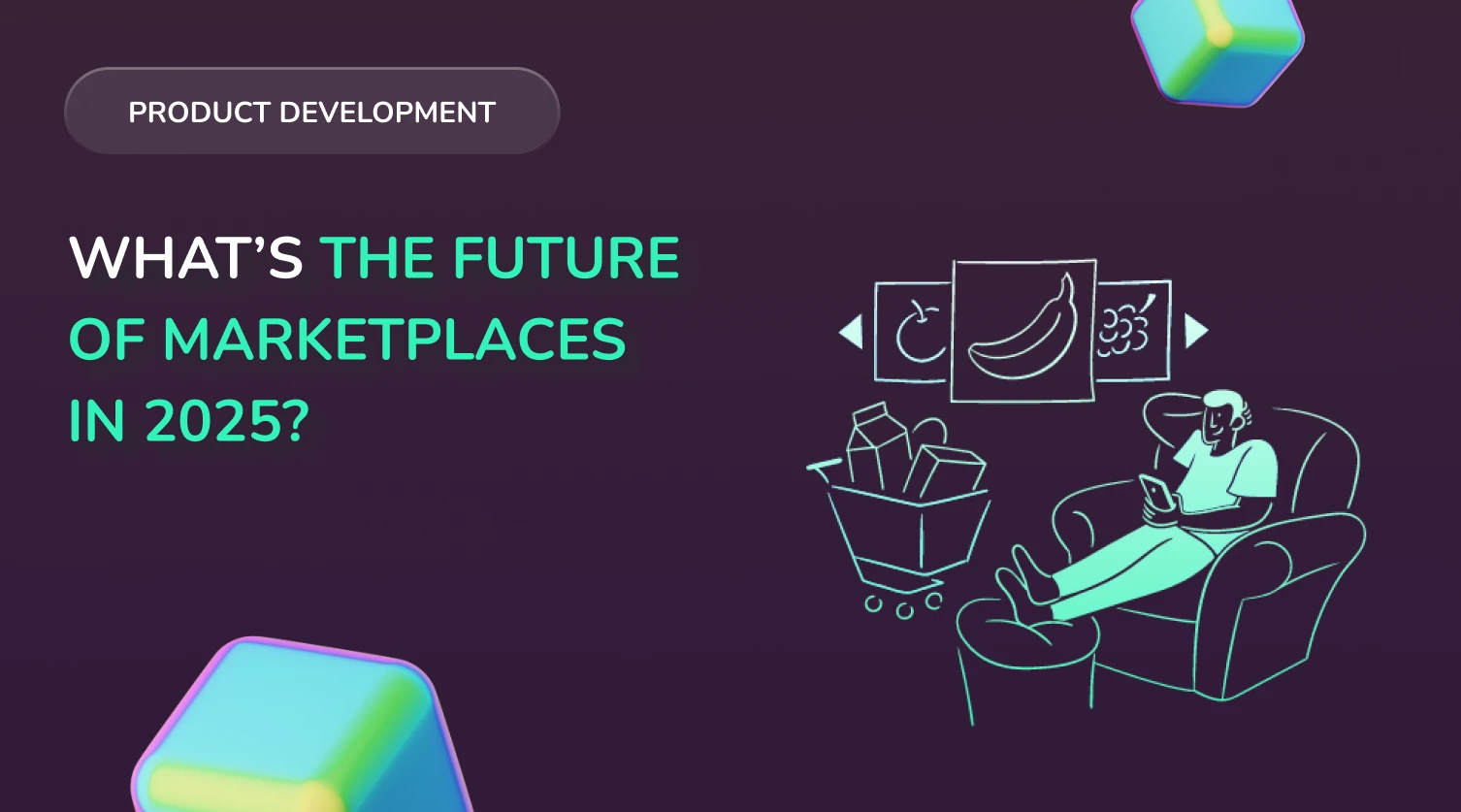
Have you ever thought that to create a thriving online marketplace in 2025, you already have everything you need — and even more? Yes, it’s not an illusion. Thanks to new technologies and changing consumer behavior (shaping the e-commerce landscape), we have enormous potential to create a thriving digital marketplace like never before. But here’s the catch: Not all marketplace ideas are created equal, and knowing which trends to follow, along with understanding the actual fund of development, can make or break your business.
Whether you’re an entrepreneur looking to launch the next big platform, an investor exploring new opportunities, or a business leader ready to expand, navigating the complex world of marketplace development can seem overwhelming. That’s why, in this guide, we’ve gathered the most promising marketplace trends and explored software tools to optimize operations. These insights will give you a clear understanding of the development level of investments so you can make confident and informed decisions when building the marketplace of the future. Want to learn how to turn your ideas into a successful and scalable platform?
Promising Marketplace Ideas for 2025
The online marketplace landscape is set to undergo significant transformations in 2025, driven by technological advancements and evolving consumer behaviors. Building upon the previously discussed concepts, here are additional promising marketplace ideas:
1. Social Commerce Platforms
Social commerce seamlessly integrates social media with e-commerce, allowing users to shop directly through platforms like Instagram, TikTok, and Facebook. This model leverages user-generated content (UGC), influencer partnerships, and AI-driven personalization to enhance the shopping experience.
Key Drivers of Growth:
- AI-powered product recommendations based on browsing behavior.
- Live commerce events where influencers showcase products in real-time.
- Integrating AR/VR for virtual try-ons (e.g., Sephora’s AR beauty tools).
- Blockchain-based transactions to improve security and transparency.
The social commerce industry is projected to grow from $992 billion in 2022 to $2.9 trillion by 2026, driven by Gen Z and millennial shoppers who prefer social-first buying experiences.
2. AI-Driven Secondhand Marketplaces
The secondhand fashion and resale industry is booming, fueled by sustainability concerns and the circular economy. AI-driven platforms are transforming this space by automating product authentication, pricing optimization, and personalized recommendations.
Innovative AI Features:
- AI-based image recognition to detect counterfeit items (e.g., Entrupy for luxury goods).
- Dynamic pricing algorithms that adjust listings based on demand and market trends.
- AI-driven chatbots for enhanced customer service and dispute resolution.
- Blockchain-based digital certificates for product authenticity.
The global secondhand apparel market is expected to reach $350 billion by 2027, with AI-powered personalization and automation driving growth.
3. Web3 and Decentralized AI Marketplaces
Web3 and blockchain technology disrupt traditional marketplaces by decentralizing transactions and eliminating intermediaries. AI marketplaces in this domain allow users to buy, sell, and trade AI models, datasets, and computing power.
Blockchain and AI Advancements:
- Smart contracts that automate payments and royalties for AI-generated content.
- Decentralized identity verification to enhance privacy and security.
- Token-based reward systems that incentivize participation (e.g., Fetch.ai, SingularityNET).
- AI-driven governance models where users vote on platform changes.
The decentralized AI marketplace sector is projected to reach $500 billion by 2030, driven by demand for more open and secure AI ecosystems.
4. Live Shopping Platforms
Live commerce blends entertainment with e-commerce, allowing consumers to shop directly through live-streamed events. Popular in China, this trend is expanding globally, with brands leveraging influencers and real-time engagement to drive sales.
Key Features Driving Engagement:
- AI-powered personalization suggests relevant products during live sessions.
- Seamless checkout integration within live videos.
- Virtual reality (VR) shopping experiences where users explore digital stores.
- Gamification elements such as flash sales and interactive Q&A sessions.
The live shopping industry is expected to generate $1.2 trillion in global sales by 2026, with major retailers like Amazon, Walmart, and TikTok leading the charge.
5. Online Learning Marketplaces
E-learning is becoming more interactive and skill-focused, with marketplaces providing tailored courses, expert mentorship, and AI-powered career guidance.
Innovations Enhancing Education:
- AI-driven adaptive learning platforms that customize content based on user progress.
- Blockchain-based credentialing for verified online certifications.
- Peer-to-peer learning models where students tutor each other.
- Integration with AR/VR for immersive learning experiences.
Market Outlook: The global e-learning market is projected to reach $682.3 billion by 2033, with an increasing demand for AI-powered personalized learning.
6. Rental Marketplaces
The rental economy is growing as consumers shift from ownership to temporary access for investment efficiency and sustainability.
Key Elements Reshaping the Market:
- Peer-to-peer rental platforms for high-cost items (e.g., camera gear, tools, designer fashion).
- AI-driven pricing optimization based on demand trends.
- Subscription-based rental models (e.g., Rent the Runway for fashion).
- Blockchain smart contracts for transparent rental agreements.
The global rental marketplace industry is expected to grow by 15% annually, with key players in mobility (Turo), fashion (Le Tote), and equipment rentals (Fat Llama) leading the way.
7. Telehealth and Telemedicine Platforms
Digital healthcare is revolutionizing patient care, with telemedicine platforms offering on-demand consultations, AI-driven diagnostics, and remote monitoring.
Technological Features Transforming Healthcare:
- AI-powered chatbots for preliminary diagnostics and triage.
- IoT-enabled health monitoring devices that sync with telehealth apps.
- Blockchain for secure patient data management.
- VR-based therapy sessions for mental health treatment.
The global telehealth industry is expected to reach $191.7 billion by 2025, with rising adoption of AI-driven remote healthcare solutions.
These emerging marketplace ideas reflect the dynamic nature of e-commerce and the continuous evolution of consumer preferences. Businesses that leverage AI, blockchain, and social commerce strategies will gain a competitive edge. Entrepreneurs who tap into sustainability, digital learning, and decentralized ecosystems will be well-positioned for success in 2025 and beyond.
The Key to Success In E-commerce Marketplace Management
Operating a booming e-commerce marketplace goes beyond just launching a platform. It requires strategic, efficient management to ensure smooth daily operations, continuous growth, and scalability. Effective e-commerce marketplace management involves various aspects that enhance user experience, streamline operations, and foster long-term business success.
E-commerce Marketplace Management Software
Businesses need robust marketplace management software to manage day-to-day operations efficiently. These tools automate critical processes, reducing manual efforts and errors while enhancing productivity. Key features include:
- Inventory Tracking
With multiple vendors and products on a single platform, tracking inventory in real-time is crucial. Advanced software solutions offer centralized inventory management, allowing businesses to monitor stock levels, set alerts for low inventory, and manage product listings seamlessly across various channels. This ensures products are always available and helps avoid stockouts or overstocking.
- Vendor Coordination
A marketplace heavily depends on its network of suppliers. In working with our own and client cases, we use tools that ensure automated workflows for managing supplier registration processes, integrating product catalogs, and monitoring performance. The development of custom systems for businesses streamlines communication and data exchange, providing suppliers with continuous updates on inventory, pricing, and order status.
- Customer Support Automation
Don’t forget about your customers — the best thing you can do for them is to manage their requests and offer support to ensure their satisfaction and retention. In our practice, we integrate software solutions into the customer support service of the marketplace platform, offering:
- Automated ticket routing
- Chatbots for 24/7 support
- Detailed reporting
This allows companies to address customer issues promptly, improving service levels and user loyalty.
E-commerce Marketplace Solutions for Transactions, Refunds, and Order Fulfillment
Transactions, refunds, and order fulfillment are the backbone of a smooth marketplace operation. Solutions that handle these processes efficiently are essential for customer satisfaction and operational efficiency.
- Payment Processing
Secure, seamless transactions are a priority in any online marketplace. For example, platforms like Stripe and PayPal offer comprehensive payment gateways that handle international payments, multi-currency support, and quick transactions, ensuring vendors and customers have a smooth payment experience.
- Order Fulfillment Systems
Efficient order fulfillment ensures timely processing and delivery of orders. Platforms like ShipBob integrate logistics and shipping services directly into the marketplace, streamlining the process. These tools optimize shipping routes, manage warehouse inventory, and automate labeling and packaging. As a result, they reduce both fulfillment time and operational funds, improving customer satisfaction and profitability.
- Refund and Returns Management
A transparent system for handling returns and refunds ensures a seamless post-purchase experience for customers. Custom solutions automate the returns process, allowing customers to initiate returns and track progress quickly. This boosts customer trust and helps businesses manage refunds efficiently, minimizing financial losses for customers and vendors.
A Strategy for Long-Term Growth and Scalability
Long-term growth and scalability are critical for any marketplace, and businesses must have a strategy to ensure their marketplace can evolve as demand increases and new trends emerge. Let’s dive into the key strategies below that are essential for adapting to market demands and achieving sustained success.
- Data-Driven Insights
Effective marketplace management hinges on the ability to analyze large datasets to uncover valuable insights that drive decision-making. Businesses can track customer behavior, monitor conversion rates, and evaluate vendor performance by leveraging data analysis tools. This data-driven approach helps optimize pricing strategies and refine marketing efforts and enables businesses to make informed decisions that foster sustainable growth. Analyzing key metrics, such as traffic patterns and sales trends, equips companies with the insights they need to adapt and stay competitive in a rapidly evolving marketplace.
- Scalability Solutions
As your marketplace grows, ensuring your platform can scale efficiently is crucial. This requires adopting scalable infrastructure that can expand in response to increasing traffic and transaction volumes. Cloud-based solutions provide elastic computing power, robust database management, and flexible storage options that adapt as your business scales. With a reliable infrastructure, your marketplace will be well-positioned to handle peak demand without compromising performance, ensuring seamless user experiences even during periods of high activity.
- Global Expansion
Expanding your marketplace to international markets presents a significant opportunity for growth. To facilitate this expansion, your platform must support multi-language capabilities, multi-currency transactions, and international shipping. Ensuring a smooth user experience for global customers will enhance satisfaction and help you build a broader, more diverse customer base. Establishing a scalable system for handling international logistics and payments is essential for effectively reaching and servicing customers across different regions.
- Vendor Growth and Engagement
A booming marketplace thrives on strong, mutually beneficial relationships with its vendors. You can create a positive environment that encourages long-term collaboration by providing vendors with the right tools to manage their inventory, track sales data, and adjust pricing. Moreover, supporting vendors with training, offering incentives for top performers, and establishing continuous feedback mechanisms ensures a thriving vendor ecosystem. Nurturing these relationships will foster loyalty, increase vendor engagement, and ultimately contribute to your marketplace’s overall success and sustainability.
By focusing on these strategies — data-driven decision-making, scalable infrastructure, global reach, and vendor engagement — your business product can effectively position itself for long-term growth and scalability in the competitive marketplace landscape.
How Much Does It Cost to Develop a Marketplace in 2025?
The level of investment in developing a marketplace can vary widely depending on several key factors, including the platform’s complexity, required integrations, and the level of customization needed. At Corpsoft Solutions, we work closely with our clients to create tailored digital solutions that align with their business goals and budgets. Based on our extensive experience in marketplace development, we can offer a rough fund estimate as follows:
Basic MVP (Minimum Viable Product)
For a marketplace with basic functionality, this price typically covers core features such as user registration, product listings, basic payment processing, and a simple user interface. An MVP is a good starting point for businesses looking to test the market with a lean version of their platform. This version allows you to gather feedback and iterate quickly before committing to further investment.
Mid-Range Marketplace with Advanced Features
A more developed marketplace will include advanced user management, real-time data analytics, vendor dashboards, custom search functionality, and additional payment gateway integrations. This price range often includes more complex back-end development and customization, allowing for a better user experience and the ability to scale more efficiently as your marketplace grows.
Enterprise-Grade, Fully Custom Marketplace
For large businesses or enterprises requiring a robust, fully customized solution, the level of investments can exceed $100,000. These marketplaces typically involve extensive third-party integrations, multi-language support, advanced security protocols, and complex features like AI-driven recommendations, custom shipping algorithms, and automated fulfillment systems. The larger the business and the more specialized the platform, the higher the investment required.
Key Cost Drivers:
- Platform Complexity
The more complex the platform, the higher the development price. For example, a simple B2C marketplace may cost less than a highly specialized AI-driven platform or one that requires multi-vendor support, dynamic pricing, and advanced analytics. - Technology Stack
Custom-built solutions often require more investment than white-label platforms. While using an off-the-shelf platform might seem more economical, a custom-built platform offers greater flexibility, scalability, and long-term value. At Corpsoft Solutions, we prioritize building flexible platforms to evolve with your business and technological needs. - Third-Party Integrations
Integrating payment gateways, third-party APIs, shipping solutions, and customer analytics tools can significantly increase the development level of investments. These integrations are essential for providing a smooth user experience and ensuring the marketplace operates efficiently. The fees can rise substantially depending on the complexity and number of integrations. - Compliance & Security
Compliance and security are crucial for specific marketplaces, especially those handling sensitive data or operating in highly regulated industries like finance or healthcare. Developing a secure, compliant platform requires additional resources, but the investment is necessary to ensure that the marketplace adheres to legal and security standards.
At Corpsoft Solutions, we know that every business is unique. We offer custom solutions designed specifically for your marketplace’s needs. Whether you’re looking to build a lean MVP, a mid-range market with advanced features, or a fully custom enterprise-grade platform, we provide scalable and flexible solutions that adapt to your budget and business requirements. We work closely with you to craft the best solution that delivers optimal results without unnecessary funds.
If you’re ready to take the next step in building your online marketplace, we invite you to contact our team of experts for a consultation tailored to your vision and budget. Let’s work together to create a marketplace that will drive growth and success for your business!
Unlock Your Marketplace’s Full Potential with Custom Solutions
As we’ve explored, building a thriving marketplace in 2025 requires an idea and the right tools, strategies, and scalable solutions to turn that idea into a flourishing business. From navigating complex marketplace management to ensuring seamless user experiences, every decision impacts the growth and efficiency of your platform.
But why go it alone when you can leverage the expertise of specialists who can tailor solutions to your unique needs? At Corpsoft Solutions, we help businesses like yours create custom, scalable marketplace platforms that meet today’s demands and set you up for long-term success. Working with experts gives you access to cutting-edge technologies, data-driven insights, and seamless integrations — saving time, minimizing risk, and maximizing potential.
Ready to take your marketplace to the next level? Let’s build a solution perfectly aligned with your business goals. Reach out today to discuss how we can make your vision a reality.
FAQ
- What is a cloud marketplace?
A cloud marketplace is an online platform where businesses and individuals can buy and sell digital products like software and services hosted on the cloud. It simplifies access to various cloud-based solutions from a centralized hub.
- How to create a multi-vendor marketplace website?
To create a multi-vendor marketplace, select a platform that supports multi-vendor functionality, design an intuitive user interface, set up secure payment systems, integrate vendor management tools, and ensure scalability and security.
- What is marketplace optimization?
Marketplace optimization improves platform performance and user experience by enhancing speed, search functionality, order management, and vendor/customer satisfaction. It involves strategies to increase traffic, conversion rates, and revenue.
- How to start a marketplace startup?
Starting a marketplace involves researching a profitable niche, building a business model, developing a user-friendly platform, attracting vendors and users, and continuously iterating based on feedback to ensure growth and scalability.
Subscribe to our blog

